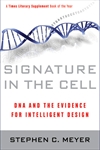Signature in the Cell is an important book for anyone interested in the status of thinking in the field of molecular biology regarding the origin of life. Stephen Meyer traces the history of thought and investigations into how life began, demonstrating how modern discoveries continue to confound and amaze scientists. Not that long ago, scientists thought cells were fairly simple, but they are now discovering that within the most simple living cell resides an amazingly complex factory-like system. The amount of information required to run the operation of each cell is staggering. So much so that the probability of even the simplest living cell arising by chance is beyond the realm of possibility. Taking only one aspect of the problem—“producing the suite of proteins necessary to service a nominally complex cell”—has a probability of only 1 out of 10 41,000. This number greatly exceeds the probabilistic resources of the entire universe (p. 218).
Meyers approaches the topic very systematically, yet he writes from his personal experience as he investigated the topic, following rabbit trails, considering various hypotheses, talking with scientists doing the most current work in the field, comparing notes.
He makes a very compelling case for the scientific validity of the intelligent design (ID) approach to this question. After studying the methods used by historical scientists both past and present, he demonstrates that the methods of ID are the same and should be accorded the same status as those of materialists. He explains how scientists frequently use “IBE”-- inference to the best explanation--in fields such as paleontology, archaeology, criminal forensics, cryptography, and other sciences. As Meyers studied the functions within cells and possibilities of various explanations for their origin, he concluded that ID is the best explanation that fits the observable facts.
Meyers deals with each of the objections and counter arguments very objectively, showing the validity or falsity of each with scientific evidence. At the end of the book he addresses the religious implications of ID, but he explains that they are not inherent to the ID approach. The ID movement is a scientific approach that seeks to examine all of the evidence rather than limiting itself to the boundaries of materialistic explanations. Along the way, he shows how scientists in some fields have already breached those boundaries, positing intelligent causes for observable artifacts such as cave paintings.
I very much appreciate the way that Meyer weighs the evidence and arguments from opposing viewpoints. He explains why they arose, what makes them worth considering, and what undermines them. This helps the reader understand the current situation in the field of microbiology in regard to questions about the origin of life. Meyers points out that many microbiologists are now rejecting materialist, evolutionary explanations in light of recent discoveries.
Meyers does not attempt to answer other questions regarding the time when the first cell or the first human arose. He limits himself to what he can speak about with confidence from his investigations within molecular biology.
It is important to note that some Christians take issue with ID scientists because they approach science from a uniformitarian perspective as does the mainstream world of science. Meyers mentions this but does not spend significant time on it.
Signature in the Cell gets into some fairly complex science. Meyers sometimes suggests places where non-scientists might want to skip an explanation and move on to a summary or the next section. While it helps to have some scientific background, the book is still very intelligible to non-scientists. It reads like the story of an investigation, carrying you along each step of the way. The arguments Meyers presents have already made an impact on the work of many other scientists as well as the origin of life debate. I highly recommend this book!










